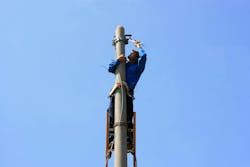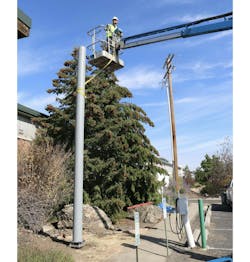Overcoming barriers to rural broadband with composite poles.
Most Americans take for granted how quickly a situation can go bad when you don’t have the ability to communicate with the rest of the world. But rural Americans fully appreciate how much this disconnection affects people’s lives.
Where I live in rural Pennsylvania, my neighbors and I have experienced the near helplessness of emergencies happening without cellular or internet access. It’s not an overstatement to say these can be cases of life and death.
This is the reality for nearly a quarter of Americans living in rural areas,1 according to the USDA, and for those working in rural jobs like logging and mining. There are two different Americas when it comes to access to the technology that drives the modern world.
On my own property in Pennsylvania, my only option was to pay for satellite internet access. Comparing notes with my city-based colleagues, I pay almost three times as much for access.
Composite utility and telecom poles are playing a key role in advancing broadband access equity across the U.S. Their lightweight, extremely resilient, customizable properties have made them a preferred choice among companies like EasyStreet Systems for small-cell installations across the rural U.S. Composite poles are changing the game for rural internet access for users, utilities, and installers.
The Challenges of Rural Broadband Buildout
Financial and physical barriers block equitable broadband access in rural communities.
Financial Barriers
The Rural Electrification Act (REA) of 1936 shifted the mindset of the government and the public to view access to electricity as a right of all Americans. Today—and even more since the COVID-19 pandemic lockdowns—our lives rely on not just electricity but also the connectivity provided by the internet. But unlike power, the internet isn’t yet treated like a public utility.
This has left rural people with no option but to self-fund their access to the internet—often at significant expense. My co-author on this piece, Sam Lynch, VP of Sales at EasyStreet Systems and a lifelong rural Georgian, told me of a gentleman in his town who had to drive 45 minutes each way to a coffee shop in Dahlonega, Georgia, to have internet access to do his job during the COVID-19 pandemic lockdowns. That same man later paid out of his own pocket to have a pole put on his property and for fixed wireless access (FWA) internet to be installed, which he uses for his own home and to serve the areas surrounding the property and a university in northern Georgia.
On my own property in Pennsylvania, my only option was to pay for satellite internet access. Comparing notes with my city-based colleagues, I pay almost three times as much for access.
Some new policies and funding reflect the spirit of the REA for internet access. The Rural Digital Opportunity Fund (RDOF)2 is a multi-phase grant project meant to bring broadband to unserved or underserved areas of the U.S. through taxpayer dollars. The Broadband Equity Access and Deployment (BEAD) Program3 is a $42.45 billion project within the Infrastructure Investment and Jobs Act (IIJA) meant to extend access to high-speed internet through funding planning, infrastructure deployment, and adoption programs across the entire U.S. and its territories.
Both programs have the admirable goal of improved access, but both programs suffer from the same slowdown: like many government-funded projects, the actual distribution of the funding has been very, very slow. One major obstacle was that BEAD funding was only available to fiber networks. To quote Forbes:4
“FWA provides wireless broadband through radio links between two fixed points that operates on licensed spectrum over LTE and 5G networks. This serves a home or business through a wireless connection to a customer premises equipment (CPE) unit that typically integrates Wi-Fi. On the other hand, fiber employs optical cable trenched underground with last-mile connections made either aerially (usually from a telephone pole) or underground depending on the topography of the homes and businesses being served. Again, CPE devices serve as the termination points, but in the case of fiber they are physically wired to the carrier network.”
While they create a more robust network, fiber is much slower, more complicated, and more expensive to install than FWA. Internet providers like Verizon, AT&T, and T-Mobile would struggle to justify the costs of plowing, installing, and burying a single mile of fiber versus covering up to 20 homes using FWA. Because of this, BEAD rules were eventually relaxed to include FWA, but major internet providers are still businesses and rural installations are less economical than urban ones.
There are two different Americas when it comes to access to the technology that drives the modern world.
Physical Barriers
The terrain itself represents a substantial physical barrier to internet access equity. Rural properties are much larger and further apart than suburban and especially urban ones. The land in between properties is often forested, hilly or in another natural state, making it extremely difficult to deliver conventional weight poles and installation crews to the sites. Sometimes, additional permits are needed. Many rural properties use well water, which means wood poles have additional regulations to avoid leaching treatment chemicals into the groundwater. And none of this considers the critters: beavers, termites, woodpeckers, squirrels and other animals and insects are plentiful and see wood poles as just another tree.
Between terrain and money, it’s no wonder that the rural broadband buildout has moved at a glacial pace. The rising adoption of composite poles, however, is helping to pick up the pace.
How Composites are Speeding Rural Access to Broadband
Sam Lynch of EasyStreet Systems is one of many telecom professionals who sees composite poles as an essential step towards a truly nationwide broadband buildout. EasyStreet specializes in small cell deployment for rural FWA. “We prefer the term ‘smart cell,’” Sam told me. “While these are low-quantity installation sales, even a single composite pole can be the smartest choice for everyone involved because they go up fast, and they last.”
Mostly working with 10-inch diameter Creative Composites Group (CCG) StormStrong® poles between 20 and 40 feet long, Sam and his colleagues are most impressed with the high strength-to-weight ratio. “As we go into rural FWA broadband, we're finding that we need taller poles that can handle more equipment without exceeding the overturning moment.” Composites are speeding rural access to broadband by overcoming the two major barriers of total cost and terrain.
Lower Total Costs
The process is impressively simple when EasyStreet is brought in to install a “smart cell” pole in a rural area. Sam reports that the carrier’s cost of construction is usually reduced between 30% and 70% when using fiber reinforced polymer (FRP) composites. “These get installed with a two- or three-person crew and a bucket truck instead of a huge crew with a crane truck,” explained Sam. “From just a personnel and equipment standpoint, these companies are saving a ton, especially when there are so many open jobs for utility and telecom line crew workers.”
Even getting the poles to the site comes with a lower price tag. A standard truck can carry about a dozen steel poles. That same truck could carry nearly 60 composite poles of the same diameter. This is economy of scale.
And because the poles are entirely sourced and made in the U.S., they qualify under the Build America, Buy America Act, a requirement for BEAD funding. This also means that everything installed on a rural site is traceable and backed by both quality assurance and accessible support. The pole will perform as expected for decades (EasyStreet estimates up to 50 years), and in Sam’s words, “We view CCG as a partner, not just a supplier.”
Less Impact
FRP composite poles have a lower environmental impact, especially in rural installations. As previously stated, composite poles are two to three times lighter than same-diameter wood poles and much lighter than steel, saving fuel on transport and labor and installation costs.
Some FRP poles, like my company’s, have earned an Environmental Product Declaration for cradle-to-gate emissions. The data shows that the global warming potential (GWP) of FRP poles versus galvanized steel, when adjusted for final weight based on equivalent strength and length, is much lower (see Figure 1).
FRP poles have a lower impact on the environment in these additional ways:
Water-Safe: Composites leach no preservatives or insecticides into the water, making them ideal for setting even near water sources. They also don’t corrode or rot when exposed to water, giving them a longer service life.
Fire-Safe: FRP poles have outstanding dielectric strength, unlike steel, and are inherently fire retardant, unlike wood. They won’t add fire risk to a property where emergency services may not be readily accessible.
Extremely Resilient: Some FRP poles, like StormStrong, have been tested—in both a lab setting and in actual natural disasters—and shown to resist hurricane-force winds, even when carrying lots of equipment like microwave dishes. The poles stay standing under even very harsh conditions, extending the service life.
Critter-Resistant: Replacing a wood pole every two to ten years due to animal damage is unrealistic for a rural FWA pole. Unlike wood poles, composite poles are not a desirable home or target for birds, insects and small mammals.
Camouflage-Ready: FRP poles do not decay and, with additional coatings from EasyStreet, resist weed-eater chemicals and even graffiti. They come standard with UV-resistant coating and may be tinted to the customer’s color of choice. This allows them to blend into the environment in which they’re installed and stay in as-new condition for longer, rather than becoming an eyesore or a hazard. Added Sam, “We’ve encountered a somewhat fixed mentality about changing material. Folks tell us, ‘We’ve always had wood poles.’ But once we show them the new material and explain the benefits, they quickly are on board.”
Internet for All is Possible
Composite poles are accelerating rural broadband buildout. “I think in the next two or three years, we’ll be seeing some sizeable deployments,” Sam said. “The need for internet isn’t getting any lower, and composites make the buildout less of a challenge.” This lightweight but super strong material is changing the reality of rural broadband installation and getting more people reliably online.
REFERENCES
1. USDA, https://www.usda.gov/broadband
2. Interagency Working Group on Coal and Power Plant Communities and Economic Revitalization, https://energycommunities.gov/funding-opportunity/rural-digital-opportunity-fund-rdof-phase-ii/
3. BroadbandUSA, https://broadbandusa.ntia.doc.gov/funding-programs/broadband-equity-access-and-deployment-bead-program
4. Forbes, https://www.forbes.com/sites/moorinsights/2023/02/20/the-5g-fixed-wireless-access-vs-fiber-debate/
About the Author
Dustin Troutman
Chief Sales Officer, Creative Composites Group
Dustin Troutman is the Chief Sales Officer at Creative Composites Group. He earned his Civil Engineering degree in 1993 and began his career in heavy construction management. With 30 years at Creative, Dustin plays a key role in market research, product development and the sale of FRP systems for CCG. For more information, email [email protected] or visit www.creativecompositesgroup.com. Follow CCG on Facebook, LinkedIn, X @CreativeCCG and YouTube.
Sam Lynch
VP of Sales, EasyStreet Systems
Sam Lynch is VP of Sales at EasyStreet Systems. He has over 38 years of experience with sales of wireless network equipment such as small cell, DAS, radio antennas, as well as outside plant equipment. He was formerly VP of Sales EMEA region for Communications Components, Inc. Sam has led other organizations as VP of Sales with the majority being Global Wireless Sales VP for ADC Telecom where he worked for 20 years, as well as other global roles with various companies and a wide breadth of product knowledge. For more information, visit www.easystreetsystems.com.



